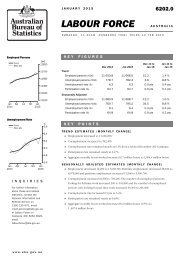Create successful ePaper yourself
Turn your PDF publications into a flip-book with our unique Google optimized e-Paper software.
Definitions<br />
DEFINITIONS<br />
Aircraft Trips<br />
Airport Movements<br />
Available Seat Kilometres<br />
(ASKs)<br />
City-Pair<br />
Flight Stage<br />
Load Factor<br />
Passengers Carried<br />
Regular Public Transport<br />
Services (RPT)<br />
Revenue Passengers<br />
Revenue Passenger<br />
Kilometres (RPKs)<br />
The number of flight stages. A return flight counts as two<br />
aircraft trips.<br />
Airport movements (passenger and cargo) are measured<br />
once on arrival and once on departure. Each domestic trip<br />
generates two movements at airports. For example, a trip<br />
from Melbourne to Sydney will be counted twice, as a<br />
passenger departure at Melbourne and as a passenger<br />
arrival at Sydney. At the national level, the sum of all<br />
domestic airport traffic will therefore be equal to twice the<br />
number of trips undertaken.<br />
Calculated by multiplying the number of seats available on<br />
each flight stage, by the distance in kilometres between the<br />
ports. The distances used are Great Circle Distances.<br />
The ports shown make up the city-pair route. Passenger<br />
movements shown for a city pair reflect total traffic in both<br />
directions.<br />
The operation of an aircraft from take-off to landing.<br />
The total revenue passenger kilometres performed as a<br />
percentage of the total available seat kilometres.<br />
Revenue passengers carried.<br />
All air service operations in which aircraft are available for<br />
the transport of members of public and are conducted in<br />
accordance with fixed schedules. It does not include charter<br />
or other non-scheduled operations.<br />
All passengers paying any fare. Frequent flyer redemption<br />
travellers are regarded as revenue passengers.<br />
Calculated by multiplying the number of revenue<br />
passengers travelling on each flight stage, by the distance in<br />
kilometres between the ports. The distances used are Great<br />
Circle Distances.<br />
Traffic on board by stages The total of all traffic (revenue passengers) on each flight<br />
stage between two directly connected airports.<br />
.. Data not included<br />
NA<br />
Not applicable<br />
25



